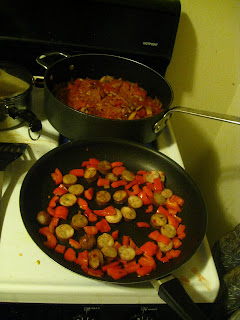 So, I've been cooking a lot of sweets recently (as you might have noticed). It's an easy way for me to get my cooking fix -- I can make a dessert, place it out in a public area, and let the vultures -- that is, college students -- descend upon it and feast. This is unlike hearty meal foods; these, I feel like I must store and eat myself. If I were to make a meal for every time I wanted to be in the kitchen, I would leftovers pouring out of the fridge. So I restrict myself to sweets for the most part.
So, I've been cooking a lot of sweets recently (as you might have noticed). It's an easy way for me to get my cooking fix -- I can make a dessert, place it out in a public area, and let the vultures -- that is, college students -- descend upon it and feast. This is unlike hearty meal foods; these, I feel like I must store and eat myself. If I were to make a meal for every time I wanted to be in the kitchen, I would leftovers pouring out of the fridge. So I restrict myself to sweets for the most part.The only problem is, sometimes the taste of sugar gets really old. This happened to me in the past week or so, and I found myself leafing through my various cookbooks looking for something new and interesting that has neither any sugar content nor meat (the missus' take on dead flesh is... limiting). I ended falling upon the Urban Italian book to find a few interesting pasta sauces. It turns out that both of them played heavily on senses other than taste. The first was a thin sauce of anchovies, garlic, thyme, and rosemary. Its smell -- ah! It seemed like gods had come down to anoint my kitchen. But all hope was dashed when I actually took a bite. The texture, the taste -- everything was wrong! The cacophony of flavours eventually resolved itself into a dull burning which, thankfully, prevented me from tasting anything else. I'm never making that again. Blech!
So it was with great trepidation that approached the second sauce. As it was some sort of broccoli pesto, I was afraid that it would have the opposite problem: that it would come across as tasteless mushed greens. And I won't deny that even up to halfway through the recipe, it still seemed like that was the direction in which it was headed. But then something magical happened. At some point after blending the broccoli to a paste with added pine nuts and cheese, the flavour blossomed into something far greater than I thought it would. I'm not sure I can describe it, seeing as it was so unexpected. But the blanched greens mixed their fresh, though mild, taste with the more pervasive parmesan to occupy the whole of my mouth. Add pine nuts for a little texture, and you have a winner.
Of course, you're not done there. You go on to add garlic, oregano, red pepper flakes, and roasted peppers to the mix. The result is one of the most colourful dishes I have ever seen. Now, I don't know what your take on colour in food is. While I recognize that it is not a necessary element, I would much rather present a dish that's interesting to look at. Scoff though you may when cooks try their hand at artistry, you can't deny that a dish like this will give you pause. It's so pretty, how could you not admire it?
 Linguini with Broccoli Rabe Pesto, Oregano, and Peppers
Linguini with Broccoli Rabe Pesto, Oregano, and PeppersFor the pesto:
- 1 bunch broccoli rabe
- 1/2 cup olive oil
- 1/4 cup pine nuts
- 1/2 tsp salt
- 2 Tbs grated Parmigiano-Reggiano or pecorino cheese
- 2 Tbs olive oil
- 2 cloves garlic, sliced thin
- 1/4 tsp red peppers flakes
- 1/2 cup grated Parmigiano-Reggiano or pecorino cheese, plus extra for sprinkling
- 1 Tbs fresh oregano leaves
- 3 roasted peppers // I won't recopy his recipe; suffice to say you should roasted them until their skins are black & blistered, with a lot of oil, salt, and pepper
- 2 Tbs bread crumbs // Optional, in my opinion
- 1 lb cooked linguini
Put a medium-sized pot of salted water on to boil to blanch the broccoli rabe.
Remove the leaves from the broccoli rabe, cutting them off right at the stem. Reserve the leaves. Trim the broccoli rabe stems so that 2-3 inches of stem remain below each floret. Cut these into thirds.
Blanch the stems and florets in the boiling water for 30sec, until the color has intensified. Remove with a slotted spoon to a bowl of ice water to stop the cooking process. Set aside.
Blanch the broccoli rabe leaves in the boiling water until they're tender, 60-90sec. Remove with a slotted spoon to a separate bowl of ice water to stop the cooking process.
When the leaves are cold, remove them from the water and squeeze out the excess water with your hands.
Combine the olive oil and the broccoli rabe leave in a blender and blend on medium until a smooth paste forms, about 30sec. Add 1/2 cup water and blend until the leaves are completely puréed, about 30sec. Add the pine nuts and blend on medium-low until smooth, about 15sec. Add the salt and the cheese and blend very briefly, about 5sec, to bring everything together. // Note: I used a food processor instead of a blender; the time to blend is then radically reduced.
To Finish the Dish

Heat the 2 Tbs of olive oil in a large pot over medium-high heat, then add the garlic and brown slightly for a minute. Add the broccoli stems and florets and the red pepper flakes and mix to combine.
Remove the pot from the heat and add the cooked linguini and pesto; blend well. Add the grated cheese and fresh oregano, and mix well to blend everything to a rich smoothness. Top with slices of the roasted red peppers, a dash more cheese, and a pinch of breadcrumbs. Voilà!













